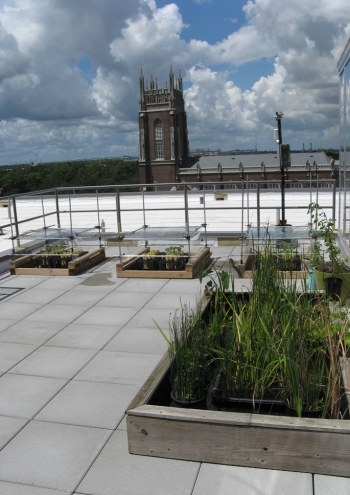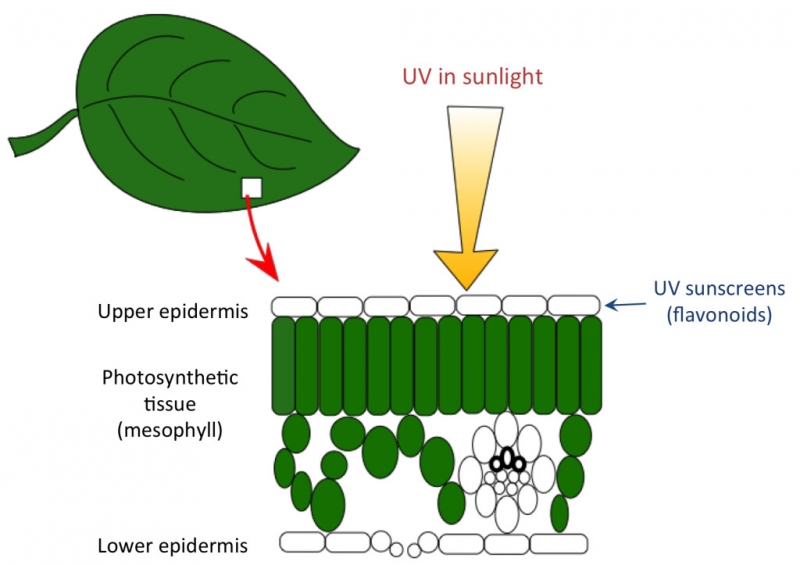
Atlas of Science
April 14, 2016
Safely basking in the sun: Some plants apply sunscreen only when they need it
Many of us are routinely advised by our dermatologists to put on our sunscreen before we go outside and to even add more sunscreen in the middle of the day when the sun’s UV rays are most intense. Wouldn’t it be nice if our bodies could sense how much UV is reaching our skin and then automatically adjust our natural sunscreen protection (in our case the pigment melanin) so as to avoid the negative effects of high UV exposure, such as skin cancer? Well, it seems that many green plants do such a thing on a regular basis. Plants have their own natural UV sunscreens (colorless pigments called flavonoids), which accumulate in their skin (epidermis), and these chemicals filter out much of the detrimental UV before it reaches sensitive photosynthetic tissue inside their leaves (Fig. 1.).

Fig. 1. A leaf cross-section of a typical broad-leaved plant illustrating the arrangement of major cells and tissues. Flavonoids accumulate in the thin epidermal tissue where they absorb UV light while transmitting visible light, which is used for photosynthesis of the mesophyll tissue. Increases in flavonoids (plant sunscreens) in the epidermis will decrease the penetration of UV to sensitive targets in the underlying tissues.
While it has long been known that plants can slowly change their level of sunscreens if they are grown in different UV environments, for example sunny vs. shaded areas, whether they could adjust their sunscreens in response to rapid changes in UV as occurs over the course of an individual day or in response to changes in cloud cover has been little studied. Several years ago while working at a high-elevation, high-UV location on Mauna Kea, Hawaii, my colleagues and I discovered that some plants could indeed increase their level of UV sunscreen protection over an individual day, adding on extra protection in the middle of the day when the sun’s UV rays were most intense and then reducing their UV protection at night when solar UV was absent. Since this initial discovery, we have found that many plants regularly adjust their UV sunscreens throughout the day (Fig. 2.).

Fig. 2. Diurnal changes in the intensity of solar UV reaching the earth’s surface under a typical clear sky (solid red line) and UV sunscreen protection (epidermal UV transmittance) in a plant that adjusts its UV protection over the day (okra; solid blue line) and one that does not (corn; dashed blue line).
In several recent papers we report that these diurnal changes in UV protection are dampened under cloudy days and can be substantially reduced when we experimentally remove just the UV from sunlight. Thus, plants seem to be sensing the amount of UV in their surroundings and quickly adjusting their levels of UV protection. It is not yet entirely clear how plants can change their sunscreen properties so rapidly but in some cases shifts in different types of flavonoids appear to be associated with these diurnal changes. Interestingly, plant species seem to vary in their abilities to adjust their UV protection in response to rapid changes in UV from the sun. Certain plants, such as okra (Abelmoschus esculentus; a common ingredient in New Orleans gumbo) are highly responsive while others, such as corn (Zea mays), are far less so and tend to maintain constant levels of UV protection day and night (Fig. 2.). The significance of this variation among species is not yet known, but it is clear that many plants are indeed far more flexible in their UV sunscreen behavior than we previously thought possible.
Additionally, certain flavonoids not only function as UV sunscreens but simultaneously play important roles in defending plants against pests and pathogens. Food plants high in flavonoids are also an important dietary source of antioxidants. Unfortunately, many vegetables, such as tomatoes and lettuce, are often grown indoors or in greenhouses where the natural diurnal UV cycles are either absent or greatly diminished. Thus, much of our produce lacks “normal” levels of flavonoids. In an effort to improve the nutritional quality of their crops while at the same time enhancing these plants’ natural defenses against herbivores and diseases, some growers are beginning to supplement light with UV from lamps. However, unless these lighting systems can mimic the natural daily cycle in sunlight, this additional UV may do more harm than good.
Paul W. Barnes
Department of Biological Sciences and Environment Program
Loyola University New Orleans
New Orleans, USA
